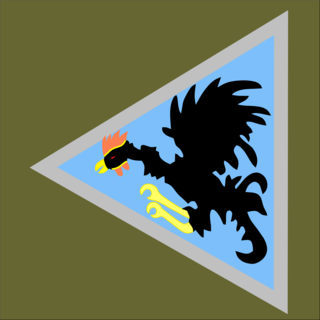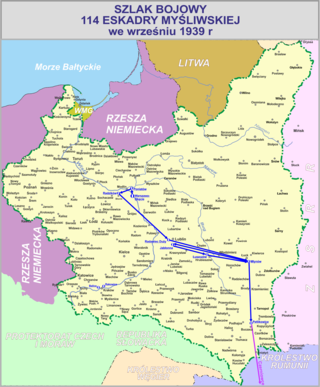Related Research Articles

The PZL.23 Karaś was a Polish light bomber and reconnaissance aircraft designed in the mid-1930s by PZL in Warsaw.

The PZL.37 Łoś ('moose') was a Polish twin-engined medium bomber designed and manufactured by national aircraft company Państwowe Zakłady Lotnicze (PZL). It is sometimes incorrectly referred to as "PZL P.37", but the letter "P" was reserved for fighters of Zygmunt Puławski's design.

The Polish Air Force is the aerial warfare branch of the Polish Armed Forces. Until July 2004 it was officially known as Wojska Lotnicze i Obrony Powietrznej. In 2014 it consisted of roughly 26,000 military personnel and about 475 aircraft, distributed among ten bases throughout Poland.

The Polish Air Forces was the name of the Polish Air Forces formed in France and the United Kingdom during World War II. The core of the Polish air units fighting alongside the Allies were experienced veterans of the 1939 invasion of Poland. They contributed to the Allied victory in the Battle of Britain and Allied air operations during the war.

The RWD-14 Czapla was a Polish army cooperation aircraft, designed in the mid-1930s by the RWD team, and produced in the LWS factory from 1938. A series of 65 aircraft were built and most were used by the Polish Air Force observation squadrons during World War II in 1939.

Lubelska Wytwórnia Samolotów was a Polish aerospace manufacturer, located in Lublin, created in 1936 from Plage i Laśkiewicz works and produced aircraft between 1936 and 1939.

The LWS-3 Mewa ("Seagull") was a Polish observation and close reconnaissance aircraft, designed in the late-1930s by the LWS factory. It was ordered by the Polish Military Aviation, but did not manage to enter service before the outbreak of World War II.

Władysław Gnyś was a Polish pilot of the Polish Air Force, a World War II flying ace and the first Polish victor in aerial combat in World War II. He briefly served as the commander of No. 317 Polish Fighter Squadron; he was shot down on his first mission over France on August 27, 1944.

The 111th Fighter Escadrille of the Polish Air Force was one of the fighter units of the Polish Army. Created in 1921, immediately after the end of the Polish-Soviet War, the unit inherited the traditions of the famous war-time Polish 7th Air Escadrille, in which both Polish and American volunteers served.

The Pursuit Brigade was a Polish World War II unit of the Polish Air Force. It took part in the Polish Defensive War of 1939 as the main aerial reserve of the commander in chief and was used for air cover of the Polish capital of Warsaw. It was similar in organization to the Bomber Brigade. It was composed of two squadrons, each in turn composed of a number of escadrilles.
The Bomber Brigade was a World War II unit of the Polish Air Force commanded by płk obs. Władysław Heller. It resisted the Invasion of Poland in 1939 as the main aerial reserve of the commander in chief and was used for bombing enemy units in central Poland. It was created just before the war and did not have time to reach full operational readiness. Its equipment consisted of 36 modern PZL.37 Łoś medium bombers, 50 older PZL.23 Karaś light bombers, as well as 21 support planes. It was organised into four squadrons, each in turn composed of two escadrilles. It was similar in make-up to the Pursuit Brigade.

Modlin Army was one of the Polish armies that were part of the Polish defense against the German Invasion of Poland. After heavy casualties in the battle of Mława, the Army was forced to abandon its positions near Warsaw around September 10; eventually it took part in the battle of Tomaszów Mazowiecki and surrendered afterwards.
The Polish Air Force, the aerial warfare branch of the Polish Armed Forces, traces its origins to the second half of 1917 and was officially established in the months following the end of World War I in 1918.

Independent Operational Group Narew was one of the Polish Army Corps that defended Poland during the Invasion of Poland in 1939. It was created on 23 March 1939 and was commanded by general Czesław Młot-Fijałkowski.

The 112th Fighter Escadrille of the Polish Air Force was one of the fighter units of the Polish Army.

The 114th Fighter Escadrille of the Polish Air Force was one of the fighter units of the Polish Army at the beginning of the WW2.

The 121st Fighter Escadrille of the Polish Air Force was one of the fighter units of the Polish Army in 1939.
Short Range Reconnaissance Escadrille was a unit of the Polish Naval Air Squadron at the beginning of world war 2.
The 42nd Reconnaissance Escadrille was a unit of the Polish Air Force at the start of World War II. The unit was attached to the Pomorze Army.

Naval Air Squadron was a unit of the Polish Air Force between the two World Wars. The unit was formed in 1920 in Puck. In 1939, it was composed of the Long Range Reconnaissance Escadrille and the Short Range Reconnaissance Escadrille
References
- "Combat Aircraft of World War Two", by John and Elke Weal, Richard F.Barker and J.M. Bruce, "Polish Aircraft" chapter, P.223-226, Polish aircraft coloured drawings, P.60-61 along drawings explains P.15-16, Ed.Arms & Armour Press, 2-6 Hampstead High Street, London NW3. England, 1977.